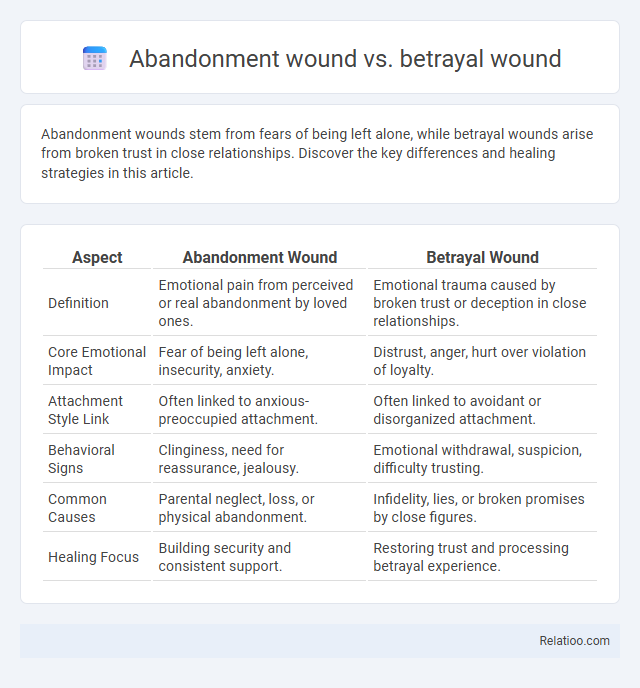Abandonment wounds stem from fears of being left alone, while betrayal wounds arise from broken trust in close relationships. Discover the key differences and healing strategies in this article.
Table of Comparison
| Aspect | Abandonment Wound | Betrayal Wound |
|---|---|---|
| Definition | Emotional pain from perceived or real abandonment by loved ones. | Emotional trauma caused by broken trust or deception in close relationships. |
| Core Emotional Impact | Fear of being left alone, insecurity, anxiety. | Distrust, anger, hurt over violation of loyalty. |
| Attachment Style Link | Often linked to anxious-preoccupied attachment. | Often linked to avoidant or disorganized attachment. |
| Behavioral Signs | Clinginess, need for reassurance, jealousy. | Emotional withdrawal, suspicion, difficulty trusting. |
| Common Causes | Parental neglect, loss, or physical abandonment. | Infidelity, lies, or broken promises by close figures. |
| Healing Focus | Building security and consistent support. | Restoring trust and processing betrayal experience. |
Understanding Abandonment Wound: Core Definitions
Understanding abandonment wound involves recognizing deep emotional pain caused by perceived or actual loss of support or connection from significant others, often rooted in early childhood experiences. Betrayal wound differs as it emerges from feelings of being deceived or violated by someone trusted, leading to broken trust and emotional trauma. While abandonment wound centers on fear of loss and loneliness, betrayal wound emphasizes mistrust and anger related to broken commitments or promises.
What is Betrayal Wound? Key Characteristics
A betrayal wound arises from a profound violation of trust, often caused by close relationships such as family, partners, or friends, leading to emotional trauma and difficulty in establishing trust in the future. Key characteristics include feelings of deep hurt, anger, confusion, shock, and a pervasive sense of insecurity that undermines self-esteem and emotional stability. Unlike abandonment wounds, which stem from neglect or physical absence, betrayal wounds involve intentional or perceived deceptive actions that shatter an expected bond or loyalty.
Root Causes: Abandonment vs Betrayal Wounds
Abandonment wounds stem primarily from experiences of neglect or loss, where Your sense of security is compromised due to physical or emotional absence during critical developmental stages. Betrayal wounds originate from breaches of trust, such as deception or infidelity, causing deep emotional pain linked to violated expectations. Understanding these root causes is essential for addressing the distinct emotional challenges associated with abandonment versus betrayal wounds.
Emotional Impact of Abandonment Wounds
Abandonment wounds deeply affect your sense of security and self-worth, often leading to feelings of loneliness, fear, and rejection. Unlike betrayal wounds, which involve broken trust and deceit by someone close, abandonment wounds center on the pain of being left behind or neglected, creating emotional scars tied to loss and neglect. Understanding the emotional impact of abandonment wounds can help you address underlying fears and develop healthier attachment patterns.
Emotional Consequences of Betrayal Wounds
Betrayal wounds often result in deep emotional turmoil, including feelings of mistrust, anger, and vulnerability, which can profoundly impact Your ability to form secure relationships. Unlike abandonment wounds that primarily evoke fear of loss and loneliness, betrayal wounds involve a breach of trust that leads to confusion and self-doubt. These emotional consequences can manifest as anxiety, resentment, and difficulty forgiving, all of which hinder emotional healing and personal growth.
Signs and Symptoms: Abandonment vs Betrayal
Abandonment wounds often manifest through intense fear of being left alone, chronic insecurity, and difficulty trusting others, while betrayal wounds typically involve feelings of deep hurt, anger, and a sense of being deceived or violated by someone trusted. Your emotional responses to abandonment may include anxiety and clinginess, whereas betrayal wounds trigger resentment, suspicion, and emotional withdrawal. Recognizing these distinct signs and symptoms is crucial for targeted healing and personal growth.
Common Triggers for Abandonment and Betrayal Wounds
Common triggers for abandonment wounds include sudden separation, emotional neglect, or perceived rejection during childhood or significant relationships, leading to feelings of unworthiness and fear of being left alone. Betrayal wounds often arise from broken trust, infidelity, or deception by trusted individuals, causing deep emotional pain and difficulty in trusting others. Both abandonment and betrayal wounds can manifest in heightened sensitivity to loss, anxiety in relationships, and a persistent fear that loved ones will desert or deceive them.
Healing Pathways: Addressing Abandonment Wounds
Healing pathways for abandonment wounds emphasize rebuilding trust and fostering secure attachments through consistent emotional support and affirmations. Therapeutic approaches like cognitive-behavioral therapy (CBT) and trauma-informed care target maladaptive beliefs and emotional regulation linked to abandonment trauma. Incorporating mindfulness practices and developing self-compassion further enhance resilience and promote long-term emotional healing from abandonment and betrayal wounds.
Healing Strategies for Betrayal Wounds
Healing strategies for betrayal wounds focus on rebuilding trust through consistent communication and setting healthy boundaries to create a sense of safety. Therapeutic approaches such as cognitive-behavioral therapy (CBT) and trauma-focused therapy help process emotions and challenge negative beliefs stemming from betrayal. Engaging in self-compassion practices and seeking supportive relationships contribute to restoring emotional resilience and promoting long-term recovery from betrayal trauma.
Moving Forward: Building Healthy Relationships Post-Wound
Healing from abandonment and betrayal wounds requires recognizing patterns of mistrust and fear that impact current relationships. Emphasizing self-awareness and emotional regulation fosters resilience, allowing individuals to create boundaries and engage in healthy, supportive connections. Therapy techniques such as cognitive-behavioral therapy and trauma-informed counseling play a key role in rebuilding trust and promoting emotional healing.

Infographic: Abandonment wound vs Betrayal wound
 relatioo.com
relatioo.com